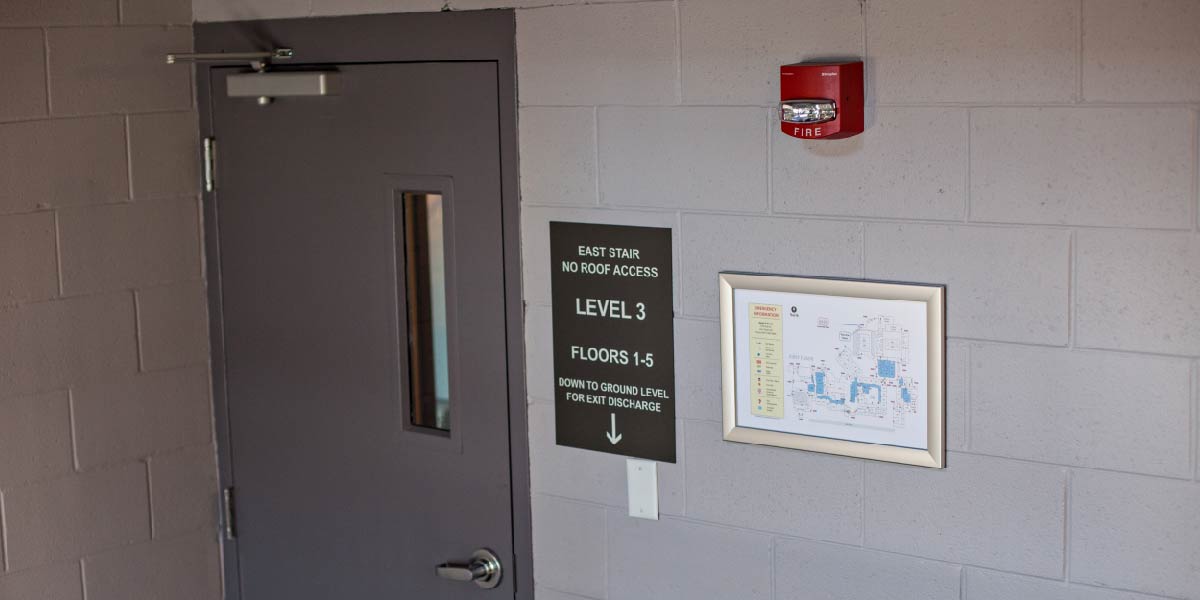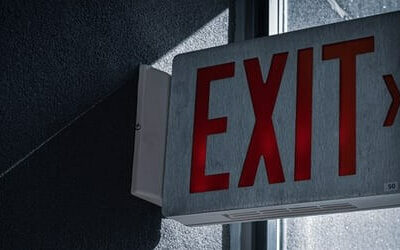Is it time to create a fire evacuation map for your business or school? An accurate, code-compliant map is an invaluable tool for safety planning. Not only does it guide occupants safely out of a building during an evacuation, but it’s also used during fire drills and to help local authorities plan emergency responses.
The three steps to create a fire evacuation map are plan, illustrate, and install.
Disclaimer
This article provides basic guidelines for creating evacuation maps. Requirements vary depending on your state and local laws. We strongly advise contacting local authorities or an evacuation mapping professional before beginning any mapping project.
1. Plan A Code-Compliant Map
Before you begin sketching your map, you must determine what authorities have jurisdiction over your business or building. The evacuation mapping requirements of those authorities will dictate the specific features of your map.
According to NFPA’s Life Safety Code, authorities that can mandate requirements are called “Authorities Having Jurisdiction” (AHJ). NFPA defines an AHJ as “An organization, office, or individual responsible for enforcing the requirements of a code or standard, or for approving equipment, materials, an installation, or a procedure.” (NFPA 101/ Life Safety Code, 2015 Edition)
Code Compliance From Multiple Authorities
The NFPA clarifies that the AHJ could be a collection of public or private entities that all have some regulatory oversight to ensure your facility meets required fire and life safety codes.
“Where public safety is primary, the AHJ may be a federal, state, local, or other regional department or individual such as a fire chief; fire marshal; chief of a fire prevention bureau, labor department, or health department; building official; electrical inspector; or others having statutory authority.”
The most common AHJ is the fire marshall, but your map might also have to follow guidelines from labor departments, health departments, and building officials.
Understand that you will often be combining the requirements of a variety of AHJs when creating your maps. If you have employees, you’ll have to include OSHA requirements. Some healthcare facilities may have special requirements from the federal Centers for Medicare and Medicaid Services.
What to Include On Your Evacuation Maps
Make a list of what to include on your fire evacuation map. Start with what’s required by your AHJs. Keep in mind that some items like fire extinguishers, fire pulls, and AEDs may not be required but would be helpful features to include.
Here’s a list of some general features to include.
- A ‘You Are Here’ location
- Primary and secondary egress routes
- All exit doors and stairwells
- Fire extinguisher, fire pulls, first aid, and medical defibrillator locations.
- An assembly area where occupants should meet after exiting the building
- A legend that illustrates and explains your map
Your map can also include information specific to your building or business, like emergency phone numbers or special instructions for assembly areas.
2. Illustrate Your Map Clearly
Your fire evacuation maps must be both accurate and easy to read. Someone using the map during an emergency shouldn’t have any questions or hesitation about where the nearest exit is or what stairwell to use.
Be Accurate
Your evacuation maps must be accurate and kept up-to-date. The best way to ensure accuracy is to use actual floorplans as a starting point. Rooms, hallways, doors, and windows should all be to scale and in the right locations. Incorrect or missing information is a danger to every building occupant. Take your time, to do it right.
Make It Easy-To-Read
A common mistake is to make overly complex evacuation maps with too much information.
Remember, the main purpose of a fire evacuation map is to instruct how to egress out of the building in an emergency. Everything else is secondary.
Tips for illustrating:
First, draw the walls and doors of your building.
Next, add specific details such as the ‘You Are Here’ location, primary and secondary egress arrows, fire extinguisher locations, and all other detail.
Now, add a compass arrow and street names outside of the walls of your building.
Orient the map to the exact direction a person is standing when viewing the map. The top of the map should be in a forward walking direction.
Finally, review your maps with those in your building. Then confirm that your drawings meet all AHJ requirements.

3. Install Your Map Properly
Where you hang your evacuation map might depend on AHJ requirements. If not otherwise indicated by your AHJ, you should have an evacuation map in each room that people regularly occupy and in the hallways.

Your maps should be permanently attached to the wall. Anti-tamper or high visibility frames can help ensure your map stays where it should and that people can find it during an emergency. Tabbed maps in a clear acrylic holder are a convenient solution for multiple safety maps. During severe weather or security emergencies, staff can easily access the appropriate map and get to safety.
Create Accurate and Code Compliant Maps with Building Maps
At first glance, creating your own safety map with a free online tool may seem like a simple and cost-effective solution. However, safety maps require meticulous care and consideration. These are not wayfinding maps to help people find their way to an office or elevator. They are critical safety tools people will rely on in an emergency to get themselves out of danger.
Here are some questions to ask yourself to help determine if you should create the map yourself or consult an expert:
- What do I know about emergency evacuation planning and egress routing?
- Do I know and understand the codes and requirements?
- Will I have time to do a good job?
- Do I have the right illustration software and illustration skills?
- Will the project be hard to manage because of the complexity or number of buildings?
- Most Importantly, will employees and visitors be able to evacuate the building based on my evacuation maps?
If you are concerned about the safety or time it will take to create evacuation maps for your company or organization, consider contacting a professional evacuation mapping company like Building Maps. Our team includes safety experts and professional illustrators who understand fire codes and life safety best practices. You can fill out this quick form to request a quote or call us at 616.866.9696 with any questions.

About the Author: Tony Jones, CFPS, is the owner and founder of Building Maps. He is a fire evacuation mapping and code compliance expert. Tony holds his work to the highest standard because he knows “it’s not just a map, it’s about saving lives.”





